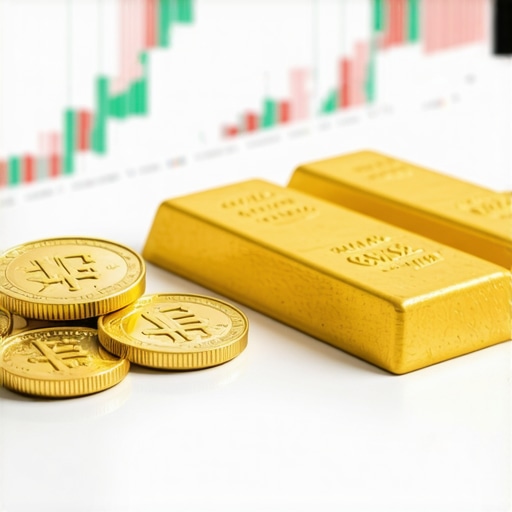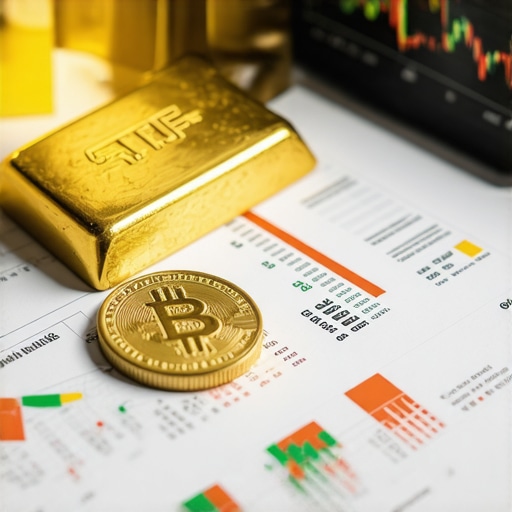Gold: The Timeless Treasure or Just Shiny Paperweight?
Imagine you’re at a bustling market, surrounded by traders hawking everything from exotic spices to precious metals. Among the glinting wares, gold has always held a special allure—not just as jewelry but as a sanctuary for wealth. But in 2025, when digital currencies and volatile stocks dominate headlines, how does one navigate the glittering maze of gold investments? Let’s dive into the captivating world of gold coins, bullion bars, and ETFs to uncover which might be your golden ticket.
Coins vs. Bars: Is Size Everything?
Gold coins have an undeniable charm, often steeped in history and artistry. They’re tangible, collectible, and sometimes even carry numismatic value beyond their gold content. Think of them as the vintage vinyl records of the precious metals world—nostalgic, valuable, and conversation starters. On the flip side, gold bars scream pure investment pragmatism. Larger, simpler, and often more cost-effective per ounce, bars are favored by those who see gold as a straightforward hedge against inflation or economic uncertainty.
Is Physical Gold Still the Heavyweight Champion in a Digital Age?
This question lingers in many investors’ minds. Physical gold—be it coins or bars—offers a tactile sense of security. You hold real, weighty wealth in your hands, impervious to server crashes or cyber hacks. Yet, it comes with storage challenges and liquidity considerations. That’s where Gold ETFs (Exchange-Traded Funds) stride in like the sleek hybrid cars of investing—offering gold exposure without the baggage of physical storage.
ETFs: The Gold Investment for the Modern Minimalist
Gold ETFs bundle the value of gold into easy-to-trade shares on stock exchanges. They provide flexibility, lower transaction costs, and instant liquidity. For those wary of counterfeit coins or the hassle of secure vaults, ETFs are a savvy alternative. However, they lack the tactile satisfaction of holding a gleaming coin or bar. It’s the difference between sipping a crafted cocktail and drinking from a can—both get the job done, but the experience varies.
For those intrigued by building a balanced gold ETF portfolio tailored for 2025’s growth landscape, [explore this comprehensive guide](https://buyingoldnow.com/how-to-build-a-balanced-gold-etf-portfolio-for-2025-growth-2) that breaks down the nuances with expert precision.
Why Does Gold Still Spark Such Investment Passion?
Beyond its shiny appeal, gold has long acted as a hedge against market volatility and inflation. According to the World Gold Council, gold’s unique properties make it a resilient asset during times of economic uncertainty (source). Whether you’re drawn to the historical allure of coins, the pragmatic heft of bars, or the modern convenience of ETFs, understanding these options equips you to make informed decisions.
Curious to hear your thoughts: Which form of gold investment resonates most with you? Have you found yourself swayed by the romance of coins or the sleek efficiency of ETFs? Share your experiences and join the conversation!
Decoding the Impact of Global Gold Demand on Your Investment Choices
Understanding the forces shaping gold’s price is vital for any savvy investor. Global demand fluctuates not only with economic cycles but also with shifting consumer preferences, technological advances, and geopolitical risks. Jewelry demand traditionally drives a significant share of gold consumption, but industrial and technological uses are steadily evolving, influencing price dynamics in nuanced ways. For a deeper dive into these trends, consider reading how jewelry and industry impact gold demand.
Can Emerging Technologies and Central Bank Policies Reshape Gold’s Role in 2025?
This question challenges investors to think beyond the traditional narratives. Central banks continue to increase their gold reserves as a strategic hedge, reinforcing gold’s status as a safe haven amid monetary policy uncertainties. Meanwhile, innovations like blockchain and tokenized gold could redefine accessibility and liquidity. According to a recent analysis by the World Gold Council, these developments may enhance gold’s appeal as both a store of value and a modern financial instrument (source).
Balancing these factors demands a nuanced approach to portfolio construction. For example, diversifying between physical gold and ETFs can optimize risk management and liquidity. To build an effective strategy tailored for 2025, explore this expert guide on balanced gold ETF portfolios.
Practical Implications: Storage, Verification, and Market Timing
While physical gold offers tangible security, it requires safe storage and authentication to avoid counterfeit risks. Trusted dealers and certified bullion coins or bars are essential for maintaining investment integrity. For those new to physical gold, learning how to verify authenticity and securely store bullion is crucial. Resources such as how to verify authentic gold coins provide invaluable guidance.
Market timing also plays a role in maximizing returns. Gold prices often react to inflation expectations, currency fluctuations, and geopolitical developments. Staying informed through reliable market analysis, such as what drives gold market changes, equips investors to make timely decisions.
Engage with Us: What Strategies Do You Employ to Balance Convenience and Security in Your Gold Investments?
We invite readers to share their approaches to balancing the tactile security of physical gold with the flexibility of ETFs. How do you weigh storage concerns against liquidity needs? Your insights contribute to a richer community understanding. Feel free to comment below and share this article with fellow investors seeking nuanced perspectives on gold investment strategies for 2025.
Innovative Custody Solutions: Bridging Physical Gold and Digital Security
As the gold investment landscape evolves, so do the methods of safeguarding your precious assets. Traditional storage methods—home safes or bank safety deposit boxes—pose risks ranging from theft to limited accessibility. Enter the era of innovative custody solutions combining blockchain technology with insured vaults. These hybrid models offer investors the tactile assurance of physical gold ownership with the convenience and security of digital verification.
For instance, platforms providing tokenized gold enable holders to trade fractionalized ownership secured by audited physical reserves stored in high-security vaults globally. This fusion of tangible assets and distributed ledger technology reduces counterparty risk while enhancing liquidity. Moreover, insured custody services now include sophisticated monitoring systems, multi-signature access protocols, and real-time auditing—features once exclusive to institutional investors.
How do tokenized gold platforms ensure authenticity and investor protection in a decentralized ecosystem?
Tokenized gold platforms rely on multiple layers of verification. Firstly, the physical gold backing each token is stored in vaults certified by recognized authorities, such as the London Bullion Market Association (LBMA). Regular audits conducted by third-party firms guarantee the reserves’ existence and purity, transparently reported to token holders. Secondly, blockchain immutability guarantees transactional integrity and traceability, preventing fraud and double-spending.
Investor protection mechanisms often include smart contracts that automate compliance and lock assets during disputes. Additionally, many platforms partner with regulated custodians and insurers to cover theft, loss, or damage. According to the World Gold Council’s 2024 report on digital gold assets, these layered safeguards are rapidly gaining acceptance, bridging the trust gap between traditional and digital asset holders (source).
Macro-Economic Indicators: Navigating Gold Investment Amidst Inflation and Geopolitical Flux
While gold is often perceived as an inflation hedge, its price dynamics are entwined with a complex web of macroeconomic factors. Investors must decipher how central bank policies, real interest rates, and currency volatility interplay to influence gold valuations in 2025.
For example, rising inflation typically boosts gold’s appeal as a store of value, but if real interest rates increase simultaneously, the opportunity cost of holding non-yielding gold rises, potentially dampening demand. Moreover, geopolitical tensions can trigger sudden gold price spikes as markets seek safe havens amidst uncertainty.
Advanced investors employ multifactor models incorporating these variables to time gold acquisitions and divestitures. Leveraging tools such as the U.S. Treasury Inflation-Protected Securities (TIPS) spread alongside geopolitical risk indices can offer nuanced insights. Engaging with comprehensive market analyses like detailed gold market forecast for 2025 aids in crafting responsive strategies.
Can real-time geopolitical risk assessment tools enhance gold portfolio resilience?
Emerging technologies now enable investors to monitor geopolitical developments in real-time, quantifying risk levels through AI-driven sentiment analysis and news aggregation. These tools feed into algorithmic trading strategies, allowing dynamic portfolio adjustments and hedging tactics that were previously inaccessible to individual investors. This proactive approach to gold investment aligns with the shifting global landscape, empowering investors to mitigate downside risks while capitalizing on safe-haven demand surges.
Tax Efficiency and Regulatory Considerations: Maximizing Returns Within Legal Frameworks
Beyond market dynamics, understanding tax implications and regulatory frameworks is paramount for optimizing gold investment returns. Different jurisdictions impose varying capital gains taxes, VAT, and reporting requirements on physical gold purchases versus gold ETFs. For example, some countries exempt investment-grade gold coins from VAT, while ETFs may be subject to dividend withholding taxes.
Expert investors often consult tax professionals to navigate these nuances, employing tax-advantaged accounts or jurisdictions to enhance post-tax yields. Awareness of evolving regulations, such as anti-money laundering (AML) directives impacting gold trading platforms, ensures compliance and avoids potential penalties.
Delving into detailed guides like gold investment tax strategies for 2025 can be instrumental in aligning investment choices with fiscal efficiency.
How do international regulatory shifts impact cross-border gold investment strategies?
Cross-border gold investments are increasingly scrutinized under global financial transparency initiatives such as the Common Reporting Standard (CRS). Investors must balance opportunities for diversification against risks of regulatory non-compliance. Understanding bilateral treaties, reporting obligations, and jurisdictional stances on gold ownership is critical in structuring international portfolios.
For those ready to elevate their gold investment approach through innovative custody, informed macroeconomic analysis, and tax-optimized strategies, continuing to engage with expert-level resources and communities is essential. Share your experiences or questions below to deepen the collective expertise on navigating gold investments in an ever-evolving 2025 market landscape.
Tokenization and Blockchain: The Next Frontier for Gold Investors
As gold investments evolve beyond traditional physical assets and ETFs, tokenization emerges as a revolutionary concept merging the tangible with the digital. Tokenized gold offers fractional ownership via blockchain-based tokens backed by audited physical reserves, combining liquidity with security. This hybrid approach appeals to investors seeking instant market access without compromising on asset authenticity. Platforms leveraging multi-layered verification and insured vault storage are rapidly gaining traction, reflecting a paradigm shift in how gold is bought, sold, and stored.
For those intrigued by this innovative custody landscape, exploring tokenized gold allows savvy investors to diversify with enhanced transparency and reduced counterparty risk. Insights from the World Gold Council’s 2024 digital gold assets report underscore the growing institutional and retail acceptance of these instruments.
What Are the Key Security Protocols That Tokenized Gold Platforms Use to Protect Investor Assets?
Tokenized gold platforms employ a suite of security protocols to ensure investor protection. Certified vault storage by recognized bodies like the London Bullion Market Association (LBMA) guarantees physical gold purity and existence. Third-party audits provide transparent verification, while blockchain’s immutable ledger secures transactional integrity. Smart contracts automate compliance and asset custody rules, minimizing fraud risks. Additionally, insured custody arrangements cover potential losses from theft or damage, bridging trust gaps between traditional and digital investors. This multi-faceted security framework is pivotal for fostering confidence in tokenized gold markets.
Harnessing AI-Powered Geopolitical Risk Assessment to Optimize Gold Portfolios
Navigating gold investments amidst geopolitical volatility demands advanced analytical tools. Artificial intelligence-driven sentiment analysis and real-time news aggregation enable investors to quantify geopolitical risks dynamically. Integrating these insights into algorithmic strategies allows portfolio adjustments that hedge against sudden market shocks and capitalize on safe-haven demand surges.
Advanced investors combine AI risk indices with economic indicators, such as inflation expectations and real interest rates, to time gold acquisitions more precisely. Such sophisticated methodologies enhance resilience and optimize returns in a rapidly shifting global landscape. For a comprehensive understanding of these multifactor approaches, delve into mastering gold market analysis insights.
Can AI-Driven Geopolitical Monitoring Replace Traditional Gold Market Forecasting?
While AI enhances predictive accuracy by processing vast, real-time data, it complements rather than replaces traditional economic models. AI excels at detecting sentiment shifts and emerging risks, offering early warnings, but human expertise remains vital to contextualize geopolitical nuances and integrate macroeconomic fundamentals. The synergy of AI tools with seasoned analysis empowers investors to craft more adaptive and informed gold strategies for 2025 and beyond.
Tax Optimization: Navigating Complexities to Maximize Gold Investment Returns
Taxation remains a critical consideration shaping net returns from gold investments. Jurisdictional variations in VAT, capital gains taxes, and reporting requirements influence the attractiveness of physical gold versus ETFs. For example, some countries exempt investment-grade gold coins from VAT, while ETFs might incur dividend withholding taxes, affecting yield profiles.
Engaging knowledgeable tax advisors and leveraging tax-advantaged accounts can significantly enhance portfolio efficiency. Staying abreast of evolving anti-money laundering (AML) regulations and cross-border reporting standards, such as the Common Reporting Standard (CRS), safeguards compliance and mitigates risks.
Investors seeking strategic tax guidance should explore gold investment tax strategies for 2025 to align their holdings with optimal fiscal frameworks.
How Do Cross-Border Regulatory Changes Impact International Gold Investment Approaches?
Increasing global financial transparency intensifies scrutiny on cross-border gold holdings. Investors must navigate complex reporting obligations and jurisdictional tax treaties while balancing diversification benefits. Understanding regulatory shifts is essential to prevent inadvertent non-compliance and to leverage international opportunities effectively. Proactive engagement with evolving frameworks ensures that gold portfolios remain legally sound and tax-efficient.
We invite experienced investors and curious newcomers alike to share your innovative gold investment strategies, particularly how you integrate emerging technologies and tax considerations into your portfolio. Join the conversation below and explore expert guidance on building balanced gold ETF portfolios to elevate your 2025 investment approach.

Expert Insights & Advanced Considerations
Tokenization Bridges Traditional Gold Ownership and Modern Liquidity
Tokenized gold platforms represent a transformative leap by combining the tangibility of physical gold with blockchain-enabled accessibility. This hybrid model mitigates counterparty risk through certified vault storage and immutability, allowing fractional ownership and instant trading. Savvy investors should consider incorporating tokenized gold to diversify liquidity and embrace forward-looking custody options, complementing traditional holdings.
AI-Powered Geopolitical Risk Assessment Enhances Portfolio Agility
Integrating AI-driven sentiment analysis and real-time news aggregation tools empowers investors to dynamically evaluate geopolitical risks influencing gold prices. This approach allows for timely portfolio adjustments that hedge against sudden market shocks and exploit safe-haven demand spikes. However, human expertise remains indispensable for contextual interpretation, underscoring the synergy between technology and seasoned analysis.
Balancing Physical Gold and ETFs Optimizes Risk and Convenience
A nuanced gold investment strategy in 2025 requires blending the tactile security of physical bullion with the liquidity and flexibility of ETFs. Physical gold offers protection against digital vulnerabilities and inflation, while ETFs provide cost-effective, liquid exposure. Investors should tailor allocations based on personal risk tolerance, storage capacity, and market outlook to harness the strengths of both forms.
Macro-Economic Indicators Remain Crucial for Timing Investment Decisions
Understanding the interplay among inflation expectations, real interest rates, central bank policies, and currency fluctuations is vital in forecasting gold price movements. Investors using multifactor models and monitoring indicators such as the U.S. Treasury Inflation-Protected Securities (TIPS) spread can optimize entry and exit timing, enhancing returns amid economic uncertainty.
Tax Efficiency and Regulatory Compliance Are Integral for Long-Term Gains
Investors must navigate complex tax regimes and evolving AML regulations across jurisdictions to maximize after-tax returns. Leveraging tax-advantaged accounts, understanding VAT exemptions on investment-grade gold, and ensuring compliance with cross-border reporting standards like the Common Reporting Standard (CRS) can significantly improve portfolio efficiency and legality.
Curated Expert Resources
- World Gold Council Research Hub: The premier authoritative source offering in-depth analyses on gold investment trends, digital gold assets, and central bank behaviors, essential for understanding market fundamentals.
Explore further at World Gold Council Gold Investment Research. - BuyingGoldNow.com Expert Guides: Comprehensive tutorials and forecasts such as building balanced gold ETF portfolios and understanding gold demand trends provide actionable strategies tailored to 2025.
- AI Geopolitical Risk Analysis Platforms: Emerging tools that offer real-time geopolitical sentiment and risk metrics to enhance decision-making in volatile markets.
- Tax Advisory Firms Specializing in Precious Metals: Firms offering nuanced consultation on cross-border gold investments, VAT implications, and AML compliance, critical for navigating regulatory landscapes.
- Industry Reports on Tokenized Gold and Blockchain Custody: Detailed examinations of security protocols, investor protections, and market adoption trends essential for evaluating digital gold innovations.
Final Expert Perspective
Gold investment in 2025 stands at a crossroads of tradition and innovation, demanding a sophisticated approach that melds physical assets, ETFs, and emerging tokenization technologies. Investors who harness AI-driven geopolitical insights while meticulously managing regulatory and tax considerations will position themselves for resilience and growth amidst economic uncertainties. The nuanced understanding of gold’s multifaceted roles—as a hedge, collectible, and digital asset—empowers informed decisions that transcend mere market speculation.
Engage with this evolving landscape by exploring expert resources like the balanced gold ETF portfolio guide and contribute your insights. How are you integrating technology and strategic analysis into your gold investments? Share your experiences to enrich this community of informed investors.










This article offers a comprehensive look into the multifaceted world of gold investing and really highlights the importance of diversifying across physical assets and digital options like ETFs and tokenized gold. Personally, I find the concept of tokenization particularly intriguing, as it bridges traditional gold investment with cutting-edge blockchain technology, potentially increasing accessibility and liquidity. However, I wonder about the practical challenges, such as ensuring the security of digital custodial platforms and safeguarding against cyber threats.